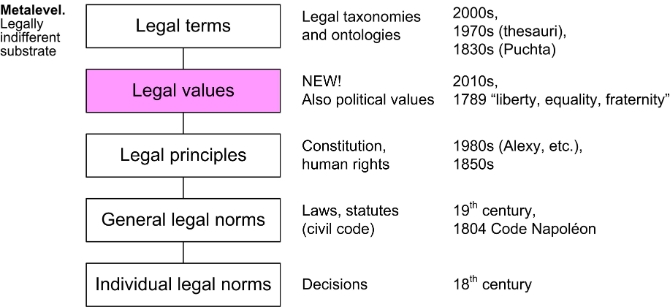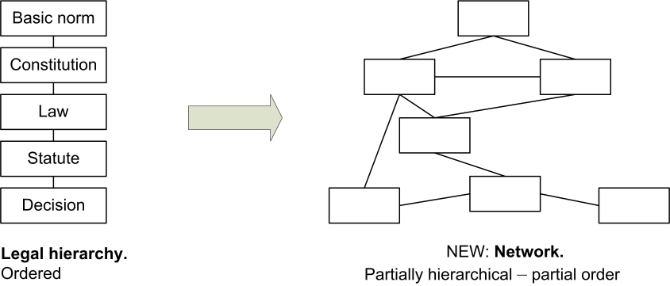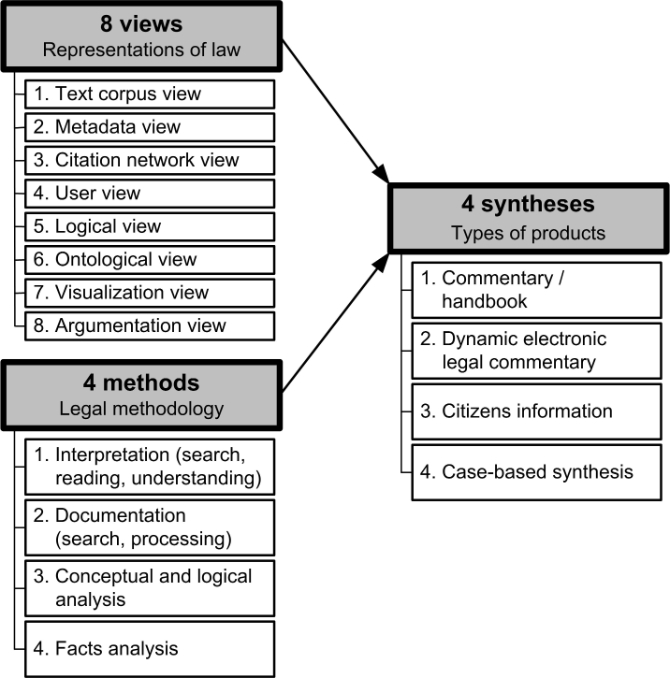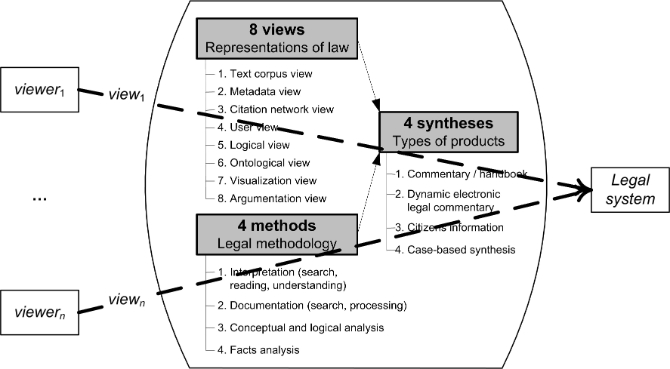1.
Introduction ^
2.
A Shift from a Hierarchy to a Network ^
3.
Relating the Network with Van Hoecke and Ost’s Multidisciplinarity ^
4.
The 8 Views/4 Methods Approach in a Nutshell ^
5.
The Notion of a View ^
5.1.
Terminology of Viewing ^
5.2.
Views of an Enterprise System ^
Five perspectives (views, levels) are shown in Figure 8, which depicts Čaplinskas» vision-driven methodological framework: 1) business level requirements (the view of a business analyst); 2) user level requirements (the view of stakeholders); 3) IS (information system) requirements (the view of an IS analyst); 4) the requirements of IS subsystems (the view of an IS engineer); 5) software requirements (the view of a software analyst). More perspectives can also be concerned:
«To be complete, it should additionally include the requirements of software components (the view of software architect), the implementation requirements (the view of software engineer), the process requirements (the view of process engineer), and the testing requirements (the view of tester).» [Čaplinskas 2009, p. 355].
5.3.
Four Views by Lu and Conrad ^
6.
Conclusions ^
7.
References ^
Čaplinskas, Albertas, Requirements elicitation in the context of enterprise engineering: a vision driven approach, Informatica, Lithuanian Academy of Sciences, 20(3), 343–368 (2009).
Goedicke, Michael, Paradigms of modular system development. In: Mitchell, Richard J. (ed.), Managing Complexity in Software Engineering, IEE Computing Series 17, pp. 1–20. Peter Peregrinus, London (1990).
Engisch, Karl, Logische Studien zur Gesetzesanwendung, 3rd edn., Heidelberg (1963).
Kelsen, Hans, Pure theory of law, 2nd edn., Max Knight (trans.) (Reine Rechtslehre, 2. Auflage. Deuticke, Wien, 1960) University of California Press, Berkeley (1967).
Kelsen, Hans, General Theory of Norms. M. Hartney, trans. Clarendon Press, Oxford (1991).
Lachmayer, Konrad, The international constitutional law approach. Vienna Journal on International Constitutional Law 1(2), 91–99. http://www.lachmayer.eu/wp-content/uploads/2014/05/2007_ICL-Journal_No-2_The-International-Constitutional-Law-Approach.pdf, accessed 5 January 2016 (2007).
Lu, Qiang; Conrad, Jack G, Bringing order to legal documents: an issue-based recommendation system via cluster association. In: Proceedings of the Fourth International Conference on Knowledge Engineering and Ontology Development (KEOD 2012), pp. 76–88. SciTePress DL. http://www.conradweb.org/~jackg/pubs/KEOD12_Lu_Conrad_STP.pdf, accessed 5 January 2016 (2012).
Lu, Qiang; Conrad, Jack G, Next generation legal search – it’s already here. VoxPopuLII blog, Cornell Legal Information Institute, 28 March 2013. http://blog.law.cornell.edu/voxpop/2013/03/28/next-generation-legal-search-its-already-here/, accessed 5 January 2016 (2013).
Martin-Bariteau, Florian, The matrix of law: from paper, to word processing, to wiki. Lex Electronica 19(1), 1–23. http://www.lex-electronica.org/docs/articles_331.pdf, accessed 5 January 2016 (2014).
Ost, François; Van de Kerchove, Michel, The legal system between order und disorder, Iain Stewart (trans.) Clarendon Press, Oxford (1993a).
Ost, François; Van de Kerchove, Michel, Constructing the complexity of the law towards a dialectic theory. http://www.dhdi.free.fr/recherches/theoriedroit/articles/ostvdkcomplex.pdf, accessed 5 January 2016 (1993b).
Ost, François; Van de Kerchove, Michel, About a pyramide or a network? On a dialectical legal theory (De la pyramide au réseau? Pour une théorie dialectique du droit). Facultés Universitaires Saint-Louis Bruxelles (2002).
Pavčnik, Marijan, Das «Hin-und Herwandern des Blickes». Zur Natur der Gesetzesanwendung. In: Rechtstheorie 39(4), 557–572. Duncker & Humblot, Berlin (2008).
Schweighofer, Erich, Reducing complexity. Through law and ICT (Reduktion von Komplexität. Durch Recht und IKT) In: Schweighofer, Erich; Geist, Anton; Heindl, Gisela; Szücs, Christian (eds.), Complexity Frontiers of Legal Informatics (Komplexitätsgrenzen der Rechtsinformatik), Proceedings of the 11th International Legal Informatics Symposium IRIS 2008, pp. 42–47. Richard Boorberg Verlag, Stuttgart [in German] (2008).
Schweighofer, Erich, Indexing as an ontological-based support for legal reasoning. In: Yearwood, John; Stranieri, Andrew (eds.), Technologies for Supporting Reasoning Communities and Collaborative Decision Making: Cooperative Approaches, IGI Global Publishers, Hershey, PA, 213–236 (2011).
Schweighofer, Erich, From information retrieval and artificial intelligence to legal data science. In: Schweighofer, Erich; Galindo, Fernando; Cerbena, Cesar (eds.), Proceedings of MWAIL 2015, ICAIL Multilingual Workshop on AI & Law Research, held in conjunction with the 15th International Conference on Artificial Intelligence & Law (ICAIL 2015), pp. 13–23. OCG, Vienna, 2015 (a).
Schweighofer, Erich, Legal semantic Web and participation. Democracia Digital e Governo Eletrônico 1(12), 50–65. http://buscalegis.ufsc.br/revistas/index.php/observatoriodoegov/article/view/34400/, accessed 5 January 2016 (b).
Sowa, John; Zachman, John, Extending and formalizing the framework for information systems architecture, IBM Systems Journal, 31(3), 590–616 (1992).
Van Hoecke, Mark; Ost, François, Epistemological perspectives in jurisprudence. Ratio Juris 6(1), 30–47 (1993). See also in: Del Mar, Maksymilian; Twining, William; Giudice, Michael (eds.) Legal Theory and the Legal Academy. Series: The Library of Essays in Contemporary Legal Theory 3, pp. 187–204, Ashgate Publishing, Farnham, UK. http://hdl.handle.net/1854/LU-1110240, accessed 5 January 2016 (2010).
- 1 «Econometrics, for example, attempts to transform economic science into a more ‹rigorous› and hence more ‹scientific› discipline by mathematical means.» [Van Hoecke & Ost 1993, p. 1]
- 2 Marijan Pavčnik quotes the idea of «Hin- und Herwandern des Blickes» (zwischen dem Normativen und dem Faktischen) in [Engisch 1963, p. 15] and also the works of other authors.
- 3 «The ‹separation of concerns› principle is realized by the concept of views. …The separation of concerns principle refers to the description of different characteristics of a software system that may or may not relate to the later execution of those systems. The principle will be applied in the division of complex description of even small portions of software into hopefully better understanding partial descriptions – that we call views – that must later be superimposed to form a complete description.» [Goedicke 1990, p. 5]
- 4 West’s Key Number System: http://info.legalsolutions.thomsonreuters.com/pdf/wln2/L-374484.pdf (accessed 5 January 2016). This is a classification system for American law.
- 5 Access to European Union law, http://eur-lex.europa.eu/ (accessed 5 January 2016).








![Figure 9: The set of evidence (views) that can be used by modern legal search engines; see [Lu & Conrad 2013] at http://blog.law.cornell.edu/voxpop/2013/03/28/next-generation-legal-search-its-already-here/](/magnoliaAuthor/.imaging/stk/jusletterit/content/dam/publicationsystem/articles/Jusletter-IT/2016/IRIS/network-of-legal-met_484b12cb6f/images/Cyras_VS_FL_ES_Abb.-9/jcr:content/1135292756Picture11.jpg.jpg)
![Figure 10: An example of a headnote with its assigned key number [Lu & Conrad 2012, Fig. 2]](/magnoliaAuthor/.imaging/stk/jusletterit/content/dam/publicationsystem/articles/Jusletter-IT/2016/IRIS/network-of-legal-met_484b12cb6f/images/Cyras_VS_FL_ES_Abb.-10/jcr:content/473146497Picture5.jpg.jpg)





